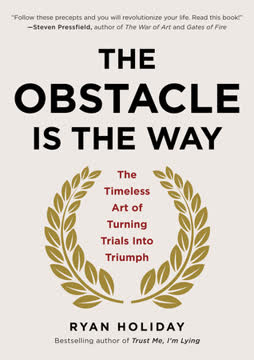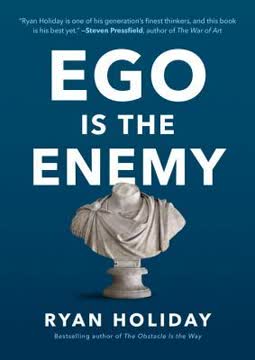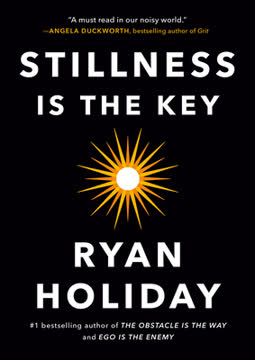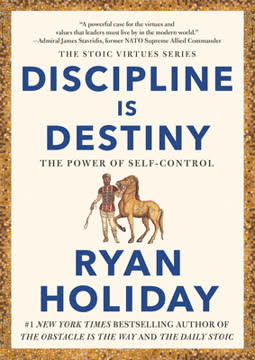Key Takeaways
1. Embrace Stoicism as a practical philosophy for life
"For who would not hate such a man?"
Stoicism as a way of life. Stoicism offers a practical approach to living wisely and virtuously. It emphasizes focusing on what is within our control, primarily our thoughts and actions, while accepting external events with equanimity. The philosophy teaches that true happiness comes from cultivating virtue and wisdom, rather than pursuing external pleasures or material possessions.
Key Stoic practices:
- Regular self-reflection and journaling
- Practicing gratitude and contentment
- Visualizing potential adversities to build resilience
- Cultivating rational thinking and emotional regulation
- Focusing on ethical behavior and social responsibility
Stoicism provides a framework for personal growth and emotional resilience, enabling individuals to navigate life's challenges with greater calm and purpose.
2. Cultivate inner peace through rational thinking
"The universe is change: life is opinion."
Rational perspective. Stoicism teaches that our judgments about events, not the events themselves, cause our distress. By cultivating rational thinking, we can achieve greater inner peace and emotional stability. This involves examining our beliefs and assumptions, separating facts from opinions, and adopting a more objective view of situations.
Techniques for rational thinking:
- Identify and challenge irrational thoughts
- Practice cognitive reframing
- Use the "view from above" technique to gain perspective
- Focus on what is within your control
- Embrace change and impermanence
By developing a more rational outlook, we can reduce unnecessary suffering and maintain tranquility in the face of life's ups and downs.
3. Practice cognitive distancing to manage emotions
"It's not events that upset us but our judgments about them."
Emotional regulation. Cognitive distancing is a key Stoic technique for managing emotions. It involves creating mental space between oneself and one's thoughts or emotions, allowing for a more objective evaluation of the situation. This practice helps prevent automatic emotional reactions and promotes more thoughtful responses to challenging situations.
Steps for cognitive distancing:
- Recognize that thoughts are not facts
- Observe thoughts and emotions without judgment
- Use language that creates distance (e.g., "I'm having the thought that..." instead of "I am...")
- Imagine viewing the situation from an outsider's perspective
- Delay reacting to allow time for rational evaluation
By mastering cognitive distancing, individuals can gain greater control over their emotional responses and maintain equanimity in the face of adversity.
4. Overcome unhealthy desires through self-discipline
"To be angry is not manly but rather a mild and gentle disposition is more manly because it is more human."
Mastering desires. Stoicism emphasizes the importance of self-discipline in overcoming unhealthy desires and cultivating virtuous behavior. This involves recognizing that true fulfillment comes from living according to reason and virtue, rather than indulging in fleeting pleasures or excessive material pursuits.
Strategies for cultivating self-discipline:
- Practice delayed gratification
- Regularly engage in voluntary discomfort
- Set clear goals aligned with your values
- Develop healthy habits through consistent practice
- Reflect on the consequences of giving in to unhealthy desires
By mastering our desires, we can achieve greater freedom and contentment, focusing our energy on what truly matters in life.
5. Develop resilience in the face of pain and adversity
"Nothing happens to anyone that he is not fitted by Nature to bear."
Building mental toughness. Stoicism teaches that adversity is an inevitable part of life and provides tools for developing resilience. By reframing challenges as opportunities for growth and viewing pain as a natural part of the human experience, we can build mental toughness and maintain equanimity in difficult times.
Techniques for developing resilience:
- Practice negative visualization
- Focus on what you can control
- Cultivate a growth mindset
- Find meaning in adversity
- Learn from past experiences of overcoming challenges
Developing resilience allows us to face life's difficulties with greater courage and composure, ultimately leading to personal growth and inner strength.
6. Master anger through empathy and understanding
"We ought not to act and speak as if we were asleep."
Anger management. Stoicism offers powerful strategies for managing anger by promoting empathy and understanding. By recognizing that people's actions are often driven by ignorance or misunderstanding rather than malice, we can respond to provocations with greater patience and compassion.
Approaches to mastering anger:
- Practice cognitive reframing of triggering situations
- Cultivate empathy by considering others' perspectives
- Use the "pause" technique before reacting
- Focus on rational problem-solving rather than emotional venting
- Remember that anger often harms the angry person more than its target
By mastering anger, we can maintain better relationships, make wiser decisions, and preserve our inner peace.
7. Face death with equanimity and acceptance
"To learn how to die is to unlearn how to be a slave."
Embracing mortality. Stoicism teaches that accepting our mortality is key to living a fulfilling life. By regularly contemplating death and viewing it as a natural part of existence, we can overcome the fear that often paralyzes us and live more authentically and purposefully.
Practices for facing death:
- Regular meditation on mortality
- Prioritize what truly matters in life
- Live each day as if it were your last
- Practice gratitude for the time you have
- Reflect on the legacy you want to leave behind
By facing death with equanimity, we can paradoxically enhance our appreciation for life and focus on what truly matters, leading to a more meaningful and purposeful existence.
Last updated:
FAQ
What's How to Think Like a Roman Emperor about?
- Exploration of Stoicism: The book delves into the life and philosophy of Marcus Aurelius, focusing on how his Stoic beliefs influenced his leadership and character.
- Personal Journey: Donald J. Robertson intertwines his own experiences with Stoicism, demonstrating its relevance to modern life.
- Practical Philosophy: It emphasizes Stoicism as a practical philosophy, offering techniques and exercises for emotional resilience and moral integrity.
Why should I read How to Think Like a Roman Emperor?
- Timeless Wisdom: Gain insights from Marcus Aurelius's reflections, which address contemporary challenges like anxiety and stress.
- Self-Improvement Tools: The book provides practical exercises and methods from Stoic philosophy for personal development.
- Engaging Narrative: Robertson combines historical anecdotes with personal stories, making philosophical concepts accessible and engaging.
What are the key takeaways of How to Think Like a Roman Emperor?
- Emotional Resilience: Learn to manage emotions through Stoic practices for greater emotional stability.
- Virtue as the Highest Good: True fulfillment comes from living virtuously, not from external pleasures or material wealth.
- Perspective on Mortality: Contemplating mortality fosters a deeper appreciation for life and reduces the fear of death.
What are the best quotes from How to Think Like a Roman Emperor and what do they mean?
- "Waste no more time arguing about what a good man should be; just be one.": Encourages action over debate, emphasizing embodying virtue.
- "It’s not things that upset us but our judgments about things.": Highlights the Stoic belief that emotions are shaped by perceptions, not events.
- "Know Thyself.": Calls for self-awareness, underscoring the importance of understanding one's thoughts and motivations.
What is Stoicism, as described in How to Think Like a Roman Emperor?
- Philosophy of Life: Stoicism is a way of life emphasizing rationality, virtue, and emotional resilience.
- Core Virtues: Advocates for wisdom, justice, courage, and moderation to guide ethical behavior.
- Indifference to External Events: Teaches that external circumstances are indifferent; what matters is responding with virtue and reason.
How does Marcus Aurelius exemplify Stoic principles in his life?
- Personal Reflections: Through The Meditations, Marcus reflects on his struggles and Stoic practices to maintain composure and virtue.
- Facing Adversity: Despite challenges like wars and personal losses, he remained committed to Stoic ideals, demonstrating resilience.
- Role Model: Marcus serves as a model for applying Stoicism in leadership, guiding ethical governance and personal conduct.
How does How to Think Like a Roman Emperor connect Stoicism with modern psychotherapy?
- Cognitive-Behavioral Therapy (CBT): The book draws parallels between Stoic techniques and modern CBT practices, addressing emotional distress through rational thinking.
- Therapeutic Exercises: Many Stoic exercises are early forms of psychological techniques used in contemporary therapy.
- Emotional Resilience: Both Stoicism and modern therapy emphasize developing resilience and coping strategies for life's challenges.
What specific methods or exercises does How to Think Like a Roman Emperor recommend for practicing Stoicism?
- Morning and Evening Meditations: Reflect on values and actions daily to cultivate self-awareness.
- Cognitive Distancing: Practice separating emotional responses from external events for a rational perspective.
- Values Clarification: Identify and write down personal values to align daily actions with what is truly important.
How does How to Think Like a Roman Emperor address the concept of fear?
- Premeditation of Adversity: Visualizing potential fears and challenges prepares individuals to face them calmly.
- Cognitive Distancing: Recognize that fear often stems from judgments about potential outcomes.
- Acceptance of Uncertainty: Encourages acceptance of uncertainty, alleviating the burden of fear.
What strategies does Marcus Aurelius use to cope with anger in How to Think Like a Roman Emperor?
- Self-Monitoring: Be aware of early signs of anger, such as physical tension or negative thoughts.
- Cognitive Distancing: Understand that anger arises from judgments about others' actions, not the actions themselves.
- Empathy and Understanding: View others as flawed humans acting out of ignorance, fostering compassion.
What is the significance of the "reserve clause" in How to Think Like a Roman Emperor?
- Acceptance of Uncertainty: Acknowledge that outcomes are not entirely under control, reducing anxiety.
- Focus on Virtue: Prioritize virtuous actions over specific outcomes, emphasizing intention.
- Emotional Detachment: Maintain composure regardless of outcomes, fostering resilience.
How does How to Think Like a Roman Emperor address the theme of death?
- Contemplation of Mortality: Reflect on mortality to live more fully and reduce fear of death.
- Acceptance of Change: Emphasizes that death is a natural part of life and should be accepted.
- Perspective Shift: View death as a return to Nature, alleviating fear and encouraging a balanced view of life and death.
Review Summary
How to Think Like a Roman Emperor receives high praise for its accessible blend of Stoic philosophy, Marcus Aurelius's biography, and modern psychology. Readers appreciate Robertson's ability to make ancient wisdom relevant to contemporary life, drawing parallels between Stoicism and cognitive behavioral therapy. The book is lauded for its practical advice on managing emotions, developing resilience, and cultivating virtue. Many find it both educational and inspirational, offering valuable insights into Stoic principles and their application in daily life. Some reviewers note its effectiveness as an introduction to Stoicism and Marcus Aurelius.
Similar Books










Download PDF
Download EPUB
.epub digital book format is ideal for reading ebooks on phones, tablets, and e-readers.









